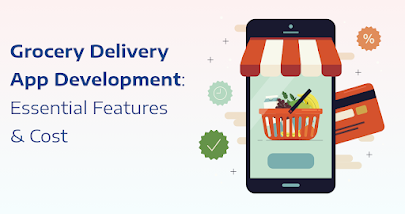In an era marked by convenience and efficiency, the grocery delivery market has experienced a significant surge in demand, especially accelerated by recent global events. As consumers increasingly prioritize safety, convenience, and time-saving solutions, grocery delivery apps have emerged as indispensable tools for modern living. For entrepreneurs venturing into this lucrative market, understanding the essential features and associated costs of developing a grocery delivery app is paramount. So, let's explore the key aspects involved in creating a successful grocery delivery app.
User-Friendly Interface
The user interface (UI) of a grocery delivery app plays a pivotal role in shaping the overall user experience. A clean, intuitive interface with easy navigation enhances user engagement and encourages repeat usage. Features such as personalized product recommendations, seamless search functionality, and a user-friendly checkout process contribute to a positive user experience, fostering customer loyalty and satisfaction.
Comprehensive Product Catalog
A robust product catalog is essential for a grocery delivery app's success. It should encompass a wide range of categories, including fresh produce, pantry staples, household essentials, and specialty items. Organizing products into intuitive categories and providing detailed product descriptions, images, and nutritional information empowers users to make informed purchasing decisions, enhancing their shopping experience.
Flexible Ordering and Delivery Options
Offering flexible ordering and delivery options caters to diverse customer preferences and enhances convenience. Features such as scheduled deliveries, express delivery for urgent orders, and multiple payment methods (credit/debit cards, digital wallets) provide users with greater control and flexibility over their shopping experience.
Real-Time Order Tracking
Transparency and real-time communication are vital for building trust and confidence among users. Integrating real-time order tracking functionality allows users to track their orders from placement to delivery, providing visibility into the delivery process and estimated arrival times. Additionally, sending proactive notifications and updates ensures a seamless and transparent delivery experience.
Secure Payment Gateway Integration
A secure and seamless payment gateway is essential for facilitating smooth transactions and safeguarding user data. Integrating trusted payment gateways with robust security features ensures safe and reliable transactions, instilling confidence in users and minimizing the risk of fraudulent activities.
Customer Support and Feedback Mechanism
Providing exceptional customer support is crucial for addressing user queries, resolving issues, and fostering customer satisfaction. Implementing a responsive customer support system via live chat, email, or phone enables timely assistance and support. Additionally, incorporating a feedback mechanism allows users to share their experiences, suggestions, and concerns, facilitating continuous improvement and enhancing customer engagement.
Inventory Management System
Efficient inventory management is essential for ensuring product availability, minimizing stockouts, and optimizing order fulfillment. Implementing an inventory management system that tracks stock levels, manages replenishment, and provides real-time inventory updates enables smooth operations and enhances customer satisfaction.
Scalability and Performance Optimization
As your grocery delivery app grows, scalability and performance optimization become critical factors. Building a scalable architecture that can accommodate increasing user demand and traffic spikes ensures uninterrupted service delivery and a seamless user experience. Additionally, optimizing app performance through caching, load balancing, and database optimization enhances responsiveness and speed, contributing to overall user satisfaction.
Now, let's delve into the cost considerations associated with developing a grocery delivery app. The cost of developing a grocery delivery app depends on various factors, including the complexity of features, technology stack, development team composition, and project timeline. A basic grocery delivery app with essential features can cost anywhere from $20,000 to $50,000, while a more advanced app with additional features and customization may require an investment of $50,000 to $100,000 or more. Additionally, ongoing maintenance, updates, and marketing expenses should be factored into the overall cost.
In conclusion, developing a successful grocery delivery app requires careful planning, attention to detail, and a customer-centric approach. By incorporating essential features, ensuring seamless functionality, and prioritizing user experience, you can create a competitive advantage and capitalize on the growing demand for convenient and efficient grocery delivery services. While the initial investment may seem daunting, the potential for long-term success and profitability in this thriving market makes it a worthwhile endeavor for aspiring entrepreneurs.





No comments:
Post a Comment